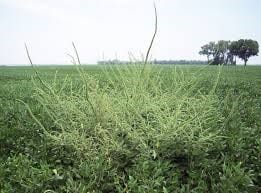 Palmer Amaranth
Palmer Amaranth
Family: Pigweed, Amaranthaceae.
Habitat: Crop fields, pastures, and roadsides.
Life cycle: Summer annual.
Growth habit: Erect up to 6 ft. high.
Leaves: Prominent white veins on the undersurface unlike redroot pigweed, not pubescent, alternate, without hairs (glabrous), and lance or egg-shaped. Leaves are 2 to 8 inches long and 1/2 to 2 1/2 inches wide with prominent white veins on the undersurface. Leaves occur on relatively long petioles.
Flower: Small, green, inconspicuous flowers are produced in dense, compact, terminal panicles that are from 1/2 to 1 1/2 feet long. Smaller lateral flowers also occur between the stem and the leaf petioles (leaf axils). Male and female flowers occur on separate plants. Each terminal panicle contains many densely packed branched spikes that have bracts that are 3 to 6 mm long; can produce 500 thousand to 1 million seeds per plant.
Roots: Taproot that is often, but not always, reddish in color
Stem: One central stem occurs from which several lateral branches arise.
Similar Plants: Loosely resembles many other pigweed species. Palmer’s petioles are as long or longer than the actual leaf. This plant is hairless and has elongated seed heads. Leaves are typically more diamond shaped than other pigweed species, and occasionally has one hair at the tip of the leaf.
The Problem is……..Palmer amaranth is one of the most difficult weeds to control in agricultural crops. It developed a major glyphosate resistance problem in the southern US from 2006-2010, and has been spreading in the midwestern US since, causing crop loss and increases in weed management costs. Characteristics that make it a successful annual weed include: rapid growth rate; wide window of emergence (early May through late summer); prolific seed production (upwards of 500,000 seeds/plant); tendency to develop herbicide resistance; and tolerance to many post-emergence herbicides when more than 3 inches tall.
Continue reading Ohio Noxious Weed Identification – Week 21 Palmer Amaranth →
 Without that snow barrier, species such as alfalfa and timothy — the most susceptible of our non-native forages — are subject to winter injury, which thins stands. This leaves less competition for weeds to establish and flourish.
Without that snow barrier, species such as alfalfa and timothy — the most susceptible of our non-native forages — are subject to winter injury, which thins stands. This leaves less competition for weeds to establish and flourish.


